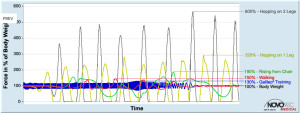Galileo’s internal forces are many times greater than the forces exerted on the user’s body
Often the question is asked about which maximum forces may occur during Galileo Training. In these discussions the device’s internal forces and accelerations are often confused with the forces that act on the athlete’s body.
The maximum forces during Galileo Training amount to 130% of body weight. A value of 100% corresponds to the body weight (when training without additional loads).
The resulting forces and accelerations that act on the body are consistently smaller than those that are created during everyday activities. Furthermore, amplitude and frequency can be easily changed and adjusted continuously. The maximum forces and accelerations are comparable with.
Measurement results
The following diagram shows typical measurement results of maximum forces per leg during Galileo Training compared with everyday movements (expressed as a multiple of g in body weight – a value of 1 is equivalent to a 1-fold body weight). It is obvious how small these maximum forces are compared to everyday movements such as walking, rising from a chair, climbing stairs, jumping on one leg or jumping on both legs.
The following diagram shows the typical maximum accelerations during Galileo Training, at the head, hip and knees compared to those during the same everyday movements.
Time analysis of measurement results and direct comparison
In the graph below the sum of ground reaction forces (for both legs) are displayed. A value of 100% corresponds to the body weight. Standing still therefore means that a force according to the body mass acts on the legs. For a person of 80 kg body weight a force of 800N.
Maximum forces
- 130% of body weight during Galileo Training
- 150% of body weight during Walking
- 190% of body weight during Rising from a chair
- 320% of body weight during Jumping on one leg
- 600% of body weight during Jumping on both legs



